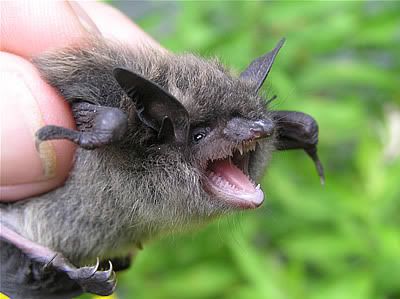
Danger! The little brown bat is one of six bat species in the northeastern United States affected by an ongoing epidemic associated with White Nose Syndrome (WNS). Photo from Mammalwatching.com.
Robert Zimmerman reports in the 29 May issue of Science:
An unknown killer has been wiping out populations of six species of hibernating bats in the northeastern United States in what appears to be the biggest die-off on record. So far, scientists studying the problem have more questions than answers. The task is urgent. The disappearance of these bats could have larger impacts on ecosystems, as these night flyers hunt insects that annoy humans and damage crops. And last October, a group of more than 100 participants from a science strategy meeting concluded that if the problem continues to expand at its current rate, entire species—including the endangered big-eared bat in Virginia and Indiana—could be in jeopardy.Not only do bats eat insects that destroy crops, but they are also important as pollinators and seed distributors. In February 2006, researchers in New York state began noticing a drop in bat populations and an increasing number of dead bats. This bat die-off has now spread to Vermont, Massachusetts, Connecticut, Pennsylvania, West Virginia, and Virginia.
The journal Science first published a brief report about White-Nose Syndrome in January 2009. David Blehert of the USGS's National Wildlife Health Center and thirteen coauthors described the discovery of a previously uncharacterized species of Geomyces fungus covering the muzzles, ears, and wings of little brown bats in Albany, NY. The National Wildlife Health Center of the USGS has a PDF of that paper available for free on their website.
Blehert et. al. initially speculated that the Geomyces fungus could be an emerging pathogen causing bat deaths, but researchers now think it is more likely that the fungus is opportunistically infecting bats who are already compromised by another disease. According to Zimmerman,
Further tests by Blehert's group may settle the issue. Since last fall, researchers and recreational cavers have been collecting soil samples from more than 200 sites in almost 30 states. If Geomyces spp. turns out to be present in unaffected sites distant from the syndrome's epicenter, the fungus may not be the primary pathogen. Blehert expects results by the fall.Other researchers, including DeeAnn Reeder of Bucknell University and Marianne Moore of Boston University, are exploring whether the bats' immune systems are compromised in WNS. Immune compromise could lead to infection by normally benign fungi.
It appears that the proximal cause of death in WNS may be starvation, since dead bats are found with little to no body fat reserves. H. Kathleen Dannelly of Indiana State University in Terre Haute is focusing on affected bats' ability to digest chitin (the protein in insect exoskeletons). Bats rely on gut microoganisms to produce chitinase, the enzyme that breaks down chitin. Bats with WNS appear to have abnormally low numbers of these chitinase-producing bacteria in their guts, which could lead to dangerously low body fat reserves.
Zimmerman concludes,
Meanwhile, researchers are taking measures to prevent the accidental spread of pathogens; gear is either new or thoroughly washed and disinfected. And on 26 March, FWS recommended a voluntary moratorium on all recreational caving in any state where white-nose syndrome has been found within or adjacent to its borders. Then, on 24 April, the U.S. Forest Service closed all caves and mines for 1 year in all national forests in the northeastern United States. A similar closure for the southeastern United States is expected before the end of May.The full text of the 29 May report is behind a subscription wall at Sciencemag.org for those with access.
More links:
A WNS summary from the Fish and Wildlife Service, including a list of cave closures.
There is much more about bats in general at the University of Michigan Museum of Zoology's Animal Diversity Web.




Shakesville is run as a safe space. First-time commenters: Please read Shakesville's Commenting Policy and Feminism 101 Section before commenting. We also do lots of in-thread moderation, so we ask that everyone read the entirety of any thread before commenting, to ensure compliance with any in-thread moderation. Thank you.
blog comments powered by Disqus